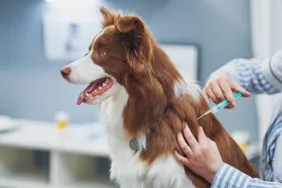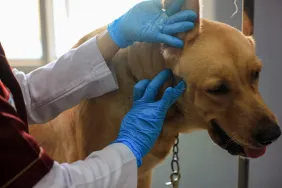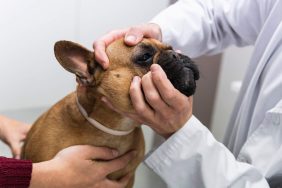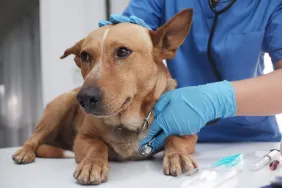Thiamine Deficiency in Dogs: Symptoms, Causes, & Treatments

Thiamine deficiency in dogs is a medical condition that can cause appetite loss, vomiting, and even seizures. Technically, the condition is also called Vitamin B1 deficiency.
Generally, canines can develop the disorder by eating nutritionally inappropriate commercial dog foods. Additionally, the food preservative sulfur dioxide can cause it.
Thankfully, taking the correct thiamine supplements can usually treat the condition. However, only add supplements to your dog’s diet after talking to your vet.
If you see signs that your dog might be suffering from this condition, then you must consult your veterinarian for a proper diagnosis and course of treatment. Here’s what you should know about the symptoms, causes, and treatments of thiamine deficiency in dogs.
@media (min-width: 0px) and (max-width: 749px) { .pb_prebidjs_300x250_a__wrapper { min-height: 250px; } } @media (min-width: 750px) { .pb_prebidjs_300x250_a__wrapper { display: none; } }
Symptoms of thiamine deficiency in dogs
Thiamine deficiency in dogs can cause a very wide range of symptoms. Generally, these symptoms can take between a few days to a few weeks to show up.
Specifically, some of the most common symptoms of the condition include:
- Vomiting
- Diarrhea
- Anorexia
- Loss of appetite
- Stomach problems
- Eye problems (including different-sized pupils)
- Acting lethargic
- Spasms
- Nervous system issues
- Weight loss
- Very high heart rate
- Seizures
Causes of thiamine deficiency in dogs

The cause of the condition is a lack of thiamine in a dog’s diet. Normally, a correct amount of thiamine helps to keep a pup’s production of energy and carbohydrate metabolism in balance.
For example, some of the most common causes of a Vitamin B1 deficiency include:
- Commercial dog foods lacking appropriate thiamine
- Eating a diet too high in carbs
- Raw fish
- Eating foods preserved with sulfur dioxide
- Vegetarian diets
Treatments for thiamine deficiency in dogs
If you think that your canine might be suffering from thiamine deficiency, your veterinarian will want to carry out a full physical examination of your dog. Additionally, your vet will ask about your dog’s diet.
Generally, blood, urine, plasma, and even saliva tests can be used to confirm a Vitamin B1 deficiency. These tests monitor the level of thiamine in your dog’s body. Technically, a test called an erythrocyte transketolase assay can accurately detect levels of thiamine in your pup.
Usually, thiamine supplements are used to treat the condition. As such, thiamine injections can be administered by your vet. Usually, these are followed by a course of oral thiamine supplements. As always, follow your vet’s precise dosage and frequency instructions when adding supplements to your canine’s diet. Also, complete the full course of supplements.
Generally, dogs who suffer from this condition will benefit from dietary changes. Your vet can help formulate a diet plan that is nutritionally appropriate for your pup’s needs.
Finally, you can check your own dog’s food for levels of thiamine at home. Recently, the Association of American Feed Control Officials has suggested that there should be one milligram of thiamine in every kilogram of food that is fed to an adult dog.

Scleritis in Dogs: Symptoms, Causes, & Treatments

Dog Vaccinations: What To Know About Your Pet’s Vaccines

Mange in Dogs: Types, Symptoms, Causes, & Treatments

Abscesses in Dogs: Symptoms, Causes, & Treatments

Atopic Dermatitis in Dogs: Symptoms, Causes, & Treatments

Skin Fold Dermatitis (Intertrigo) in Dogs: Symptoms, Causes, & Treatments




